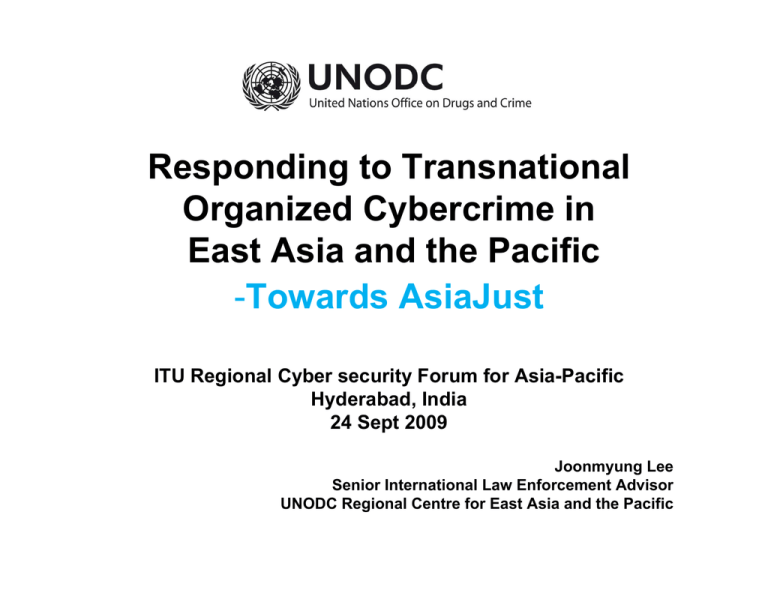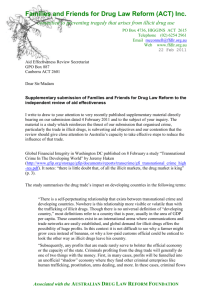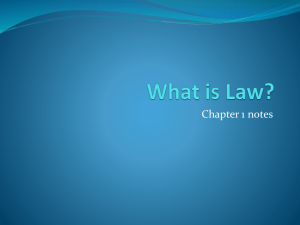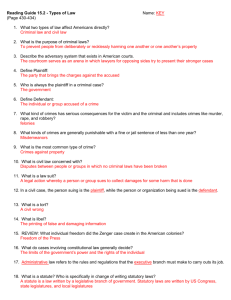Responding to Transnational Organized Cybercrime in East Asia and the Pacific Towards AsiaJust
advertisement

Responding to Transnational Organized Cybercrime in East Asia and the Pacific -Towards AsiaJust ITU Regional Cyber security Forum for Asia-Pacific Hyderabad, India 24 Sept 2009 Joonmyung Lee Senior International Law Enforcement Advisor UNODC Regional Centre for East Asia and the Pacific What has changed? • 1990s – digital revolution happens – cyberspace emerges • Lower barriers to trade and investment • Boost illicit trade as well by Transnational Organized Cybercrime “Five Wars in Cyberspace” – dirty money(fraud), drugs, arms (terrorism), human trafficking, intellectual property(pirate) • Development of TOC Network • Decentralized + adaptable • Multiple, loosely linked cells – end of “command-andcontrol” (end of the cartel model) • Inherently stateless What has changed? • Progress of TOC activities • No clear line between “good guys” and “bad guys” (cf. VB: arms, blood diamonds + frozen fish, cut flowers) • “Multi-stranded” : Separate stronghold from market place (cf. Internet Gambling Organization) • “Multiple revenue streams” : Specialize in profitable transactions – not commodities/products Result • Undermine governance – hard to control TOC beyond jurisdiction • Easier approach, harder identify • No domino effect from top-down or bottom-up approach • Response is therefore easily deferred or overlooked Why we should be worried about the region 1. Governments • Shortage of special legislation on jurisdiction • Inadequate public budgets => lags behind TOC 2. Conflict or misunderstanding between judiciary and law enforcement => gives loophole to TOC 3. Few operational judicial network beyond jurisdiction (CNCP, EJN,EroJust,OAS, IberRed) • Unbalanced assessment of cases • Wide gap of development and understanding Unable to share digital forensic equipment Legal and technical difficulty in sharing evidence • Retarding process particularly in the area of extradition, recovery of proceeds, judicial procedure What should we do? 1. Study about each other - Knowledge is threshold of mutual understanding • Co-research on the cyber situation in comparative way • Open prosecutorial practice on cybercrime • Facilitating establishment of special legislation and infra 2. Bridge the gap between the developed and the vulnerable • CBT (cf: Timorlest, EEG, E-learning) • Creating standard of digital evidence gathering 3. Exchange of Information & Evidence • Real time evidence exchange 4. Facilitate understanding on cybercrime between JD and LE • Co-workshop and training course 5. Establish International J-NETWORK : But Who, How - Towards AsiaJust Towards AsiaJust “It takes a network to defeat a network” Towards AsiaJust UNODC’s comparative advantages 1. Neutrality 2. Covering both “hard” and “soft” security issues 3. Systematic global analysis(Partnership) 4. Field presence 5. Technical expertise Regional Programme Framework for East Asia and the Pacific 2009 – 2012 HOW CAN WE ACHIEVE THIS? Regional Programme Framework 4. Drug demand reduction 1. Illicit trafficking Reduction in illicit trafficking of people, drugs and forest products 2. Governance Weaknesses in governance, including corruption, reduced 3. Criminal justice Reduction in transnational organized crimes Rule of Law Human Security: Integrated programmes of work will lead to measurable outcomes and results Reduced drug abuse 5. HIV/AIDS Health and Development Reduction in HIV/AIDS transmission 6. Sustainable livelihoods Reduced illicit opium production Vision • Long-term engagement 4. Drug demand “To 2012” or “To reduction Reduced drug abuse Human Security: 2020”? Integrated • Outcomes and results 1. Illicit trafficking Reduction in illicit trafficking of people, drugs and forest products 2. Governance Weaknesses in governance, including corruption, reduced 3. Criminal justice Reduction in serious crimes Rule of Law programmes of work will lead • to measurable outcomes and results 5. HIV/AIDS Health and Measurable Performance Development Indicators • Not a shopping list Reduction in HIV/AIDS transmission 6. Sustainable livelihoods Reduced illicit opium production Regional Programme Framework 4. Drug demand reduction 1. Illicit trafficking Reduction in illicit trafficking of people, drugs and forest products 2. Governance Weaknesses in governance, including corruption, reduced 3. Criminal justice Reduction in serious crimes Rule of Law Human Security: Integrated programmes of work will lead to measurable outcomes and results Reduced drug abuse 5. HIV/AIDS Health and Development Reduction in HIV/AIDS transmission 6. Sustainable livelihoods Reduced illicit opium production Rule of Law 3. Criminal Justice Regional Programme Framework 4. Drug demand reduction 1. Illicit trafficking Reduction in illicit trafficking of people, drugs and forest products 2. Governance Weaknesses in governance, including corruption, reduced 3. Criminal justice Reduction in serious crimes Rule of Law Human Security: Integrated programmes of work will lead to measurable outcomes and results Reduced drug abuse 5. HIV/AIDS Health and Development Reduction in HIV/AIDS transmission 6. Sustainable livelihoods Reduced illicit opium production 3. Criminal justice (Towards AJ) Rule of Law 3. Criminal Justice Reduction in serious crimes 3.1 Ratification Member states ratify international conventions and instruments 3.1.1 Member states aware of and responsive to the need for ratification 3.2 Legal Framework Legislative and regulatory frameworks established 3.2.1 Legislation drafted and enacted 3.2.2 Substantive law and rules of procedure established and used 3.2.3 Legal procedures (based on international conventions, protocols and instruments) are understood and applied 3.3 Justice System Integrity-based and accountable criminal justice systems established 3.3.1 Professional standards and oversight mechanisms established and implemented in law enforcement agencies and the judiciary 3.3.2 Coordination and cooperation mechanisms established between law enforcement agencies, prosecutors and the judiciary 3.3.3 Measures to prevent violence against women established and implemented 3.3.4 Specialised witness protection programmes established and implemented 3.3.5 Enhanced prison management regimes established and implemented 3.3.6 Juvenile and child justice systems established and implemented 3.3.7 Aware and capable crime scene examiners, law enforcement officers, prosecutors and judges 3.4 Transnational Organised Justice More efficient and effective transnational cooperation on criminal justice matters 3.4.1 Regional network of Prosecutors established and operational 3.4.2 Joint Investigation Teams established and operational 3.4.3 Judicial Liaison Networks established and operational 3.4.4 Designated Central Authorities on MLA, extradition and asset recovery established and operational 3.4.5 Baseline data established, shared and updated on transnational organised crimes 3. Criminal justice (Towards AJ) Rule of Law 3. Criminal Justice Reduction in serious crimes 3.1 Ratification Member states ratify international conventions and instruments 3.1.1 Member states aware of and responsive to the need for ratification 3.2 Legal Framework Legislative and regulatory frameworks established 3.2.1 Legislation drafted and enacted 3.2.2 Substantive law and rules of procedure established and used 3.2.3 Legal procedures (based on international conventions, protocols and instruments) are understood and applied 3.3 Justice System Integrity-based and accountable criminal justice systems established 3.3.1 Professional standards and oversight mechanisms established and implemented in law enforcement agencies and the judiciary 3.3.2 Coordination and cooperation mechanisms established between law enforcement agencies, prosecutors and the judiciary 3.3.3 Measures to prevent violence against women established and implemented 3.3.4 Specialised witness protection programmes established and implemented 3.3.5 Enhanced prison management regimes established and implemented 3.3.6 Juvenile and child justice systems established and implemented 3.3.7 Aware and capable crime scene examiners, law enforcement officers, prosecutors and judges 3.4 Transnational Organised Justice More efficient and effective transnational cooperation on criminal justice matters 3.4.1 Regional network of Prosecutors established and operational 3.4.2 Joint Investigation Teams established and operational 3.4.3 Judicial Liaison Networks established and operational 3.4.4 Designated Central Authorities on MLA, extradition and asset recovery established and operational 3.4.5 Baseline data established, shared and updated on transnational organised crimes Rule of Law 3.4 Transnational Organised Justice 3. Criminal Justice More efficient and effective transnational cooperation on criminal justice matters 3.4.2 Joint Investigation Teams established and operational 3.4.1 Regional network of Prosecutors established and operational 3.4.3 Judicial Liaison Networks established and operational (Module 1 : Pilot project with KIC) 3.4.4 Designated Central Authorities on MLA, extradition and asset recovery established and operational 3.4.5 Baseline data established, shared and updated on TOC Rule of Law 3.4 Transnational Organised Justice 3. Criminal Justice More efficient and effective transnational cooperation on criminal justice matters 3.4.2 Joint Investigation Teams established and operational 3.4.1 3.1.1Regional Membernetwork states aware of Prosecutors of and responsive established to theand operational need for ratification (Module 1 : Pilot project with KIC) 3.4.4 Designated Central Authorities on MLA, extradition and asset recovery established and operational 3.4.3 Judicial Liaison Networks established and operational 3.4.5 Baseline data established, shared and updated on TOC Activities for Pilot Project 1. Shed light on the difference of prosecutorial system and practice of each country 2. Find out obstacles of mutual understanding between LE and PS 3. Recommend and implement effective coordination mechanisms to strengthen cooperation among PR and between LE and PS. Rule of Law 3.4 Transnational Organised Justice 3. Criminal Justice More efficient and effective transnational cooperation on criminal justice matters 3.4.2 Joint Investigation Teams established and operational 3.4.1 3.1.1Regional Membernetwork states aware of Prosecutors of and responsive established to theand operational need for ratification (Module 1 : Pilot project with KIC) 3.4.4 Designated Central Authorities on MLA, extradition and asset recovery established and operational 3.4.3 Judicial Liaison Networks established and operational 3.4.5 Baseline data established, shared and updated on transnational organised crimes Activities for Pilot Project 1. Shed light on the difference of prosecutorial system and practice of each country 2. Find out obstacles of mutual understanding between LE and PS 3. Recommend and implement effective coordination mechanisms to strengthen cooperation among PR and between LE and PS. Activities for Pilot Project (2009 – 2010) 1. Shed light on the difference of judiciary countermeasure against cybercrime 2. Find out obstacles of mutual understanding between LE and PS 3. Recommend and implement effective coordination mechanisms to strengthen cooperation among PR and between LE and PS. Rule of Law 3. Criminal Justice Activities for Pilot Project 1. Shed light on the difference of prosecutorial system and practice of each country 2. Find out obstacles of mutual understanding between LE and PS 3. Recommend and implement effective coordination mechanisms to strengthen cooperation among PR and between LE and PS. Rule of Law 3. Criminal Justice Regional Programme Framework 1. Illicit trafficking 4. Drug demand reduction 2. Governance Rule of Law 3. Criminal justice Human Security: Integrated programmes of work will lead to measurable outcomes and results 5. HIV/AIDS Health and Development 6. Sustainable livelihoods Regional Programme Framework 1. Illicit trafficking 4. Drug demand reduction 2. Governance Rule of Law 3. Criminal justice Human Security: Integrated programmes of work will lead to measurable outcomes and results 5. HIV/AIDS Health and Development 6. Sustainable livelihoods THANK YOU www.unodc.org/eastasiaandpacific





